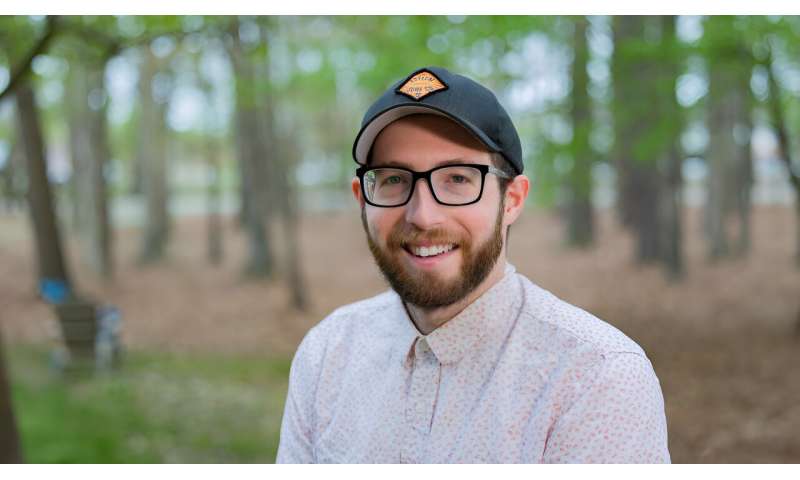Astrophysicist studies magnetrons

In the ever-evolving landscape of particle accelerators, researchers at the U.S. Department of Energy's Thomas Jefferson National Accelerator Facility constantly seek innovative solutions to enhance efficiency and reduce costs. Enter Christian Cagnino, an astrophysics major interning through the DOE's Science Undergraduate Laboratory Internship (SULI) program, whose research takes you into the intriguing world of magnetrons.
Titled "Understanding the Characteristics of Magnetrons with Magnetic Field Trimming," Cagnino's study explores the potential of the pocket-size gadgets as an alternative radiofrequency (RF) source for particle accelerators. These devices generate microwaves by crossing a stream of electrons with a magnetic field and have shown remarkable efficiency and cost-effectiveness compared to traditional alternatives.
"Magnetrons give off an unstable power due to various noise figures and oscillating frequency push when operating at different output power. This poses a major problem when trying to phase-lock the magnetron, especially when the injection frequency is out of the stable locking range," Cagnino said.
Cagnino's research proposes using coils around the permanent magnet on the magnetron tube to trim the magnetic field, potentially bringing the magnetron's natural frequency within the locking range. The implications of this research are far-reaching.
"In theory, they can generate RF more efficiently for particle accelerators at a fraction of the cost compared to current RF sources such as traditional klystrons," Cagnino said. "This could revolutionize the field, making particle accelerators more accessible and cost-effective."
While Cagnino acknowledges that his proudest moment has yet to come, his selection for the SULI internship stands out as a significant milestone.
"I have always seen myself working in a laboratory doing research and making a big impact in physics, and this is a taste of what is to come," he said.
Cagnino has had a passion for science for as long as he can remember. As a child, he recalls reading encyclopedias for fun and classifying everything he learned.
"I always loved doing math and wanted to understand the physical properties of everything," he said.
Later, a fascination with space documentaries solidified his desire to pursue astrophysics.
Despite his dreams of becoming a scientist and a deep-rooted enthusiasm for science and math, Cagnino's journey to see that dream come true took an unforeseen turn. Amid the mounting stress of family medical concerns and the overwhelming financial responsibilities that resulted, he dropped out of high school.
But Cagnino was not one to give up easily. He pushed past each obstacle and pursued his education at a continuation school, finally earning his diploma. In his free time, he obsessively watched as many videos on space as he could.
"The documentaries on space provoked my desire to understand more about the universe and were the defining moment when I knew I was interested in pursuing astrophysics," he said.
Cagnino continued his path at a community college before earning a bachelor's degree from the University of California, Santa Cruz.
Numerous mentors, including college professors and researchers such as Kevin Jordan and Haipeng Wang at Jefferson Lab, inspired Cagnino throughout his academic journey. These individuals have fostered Cagnino's passion for physics and engineering while providing invaluable guidance and connections.
"Christian is a dream student who is driven and consistently pushing himself," said Wang, Cagnino's mentor and a Jefferson Lab senior superconducting radiofrequency (SRF) accelerator physicist. "He grasps concepts fully and can then drive experiments independently to get high-quality data and analysis.
"I am fortunate to have had him since last summer. His work on the math model fitting based on his experiment data would be a critical algorithm development for the next-generation magnetron's smart controllers."
The SULI program has played a pivotal role in Cagnino's growth, pairing him with excellent mentors and offering a glimpse into the world of laboratory research.
"Despite family difficulties during childhood, Christian persevered through hard work to graduate from UCSC," Wang said. "He asks insightful questions to deepen his understanding, and his research on magnetron technology benefits not just accelerator science but also fusion research efforts with collaborators like General Atomics."
Reflecting on his experience, Cagnino spoke of valuable lessons, including the need to reinforce his physics knowledge, the challenges of translating theory into the scientific process, and the importance of effective time management.
Cagnino credits his mentors for showing him what it takes to perform research in a laboratory setting, an experience he will continue to carry with him.
Looking ahead, Cagnino envisions pursuing a Ph.D. in plasma physics or nuclear engineering, focusing on nuclear fusion or fission research. His long-term goal is still to contribute significantly to the field of physics.
Cagnino's work under the DOE's Accelerator Research & Development (R&D) and Production (ARDAP) program on compact SRF accelerators using magnetron power sources is driving significant technological developments. This collaborative effort involves Jefferson Lab, Fermilab, universities and industry partners such as General Atomics.
"By sending Christian to General Atomics to continue his research at the end of his time under the SULI program, we will further strengthen these vital research connections benefiting both education and scientific advancement," Wang said.
For those considering the SULI program, Cagnino offers sage advice: "Make the most out of every moment you get here because it goes extremely fast. Mentors are eager to have you learn anything and everything, so do your best to learn something from them."
The SULI program, part of the DOE's diverse science education missions, offers undergraduate students and recent graduates in STEM fields the opportunity to enhance their professional network, develop interests in state-of-the-art research facilities, and gain invaluable mentorship from leading experts.
As Cagnino's work demonstrates, the program nurtures the next generation of scientific minds, fostering innovation and advancing the future of STEM to make a difference in the world.
Provided by Thomas Jefferson National Accelerator Facility